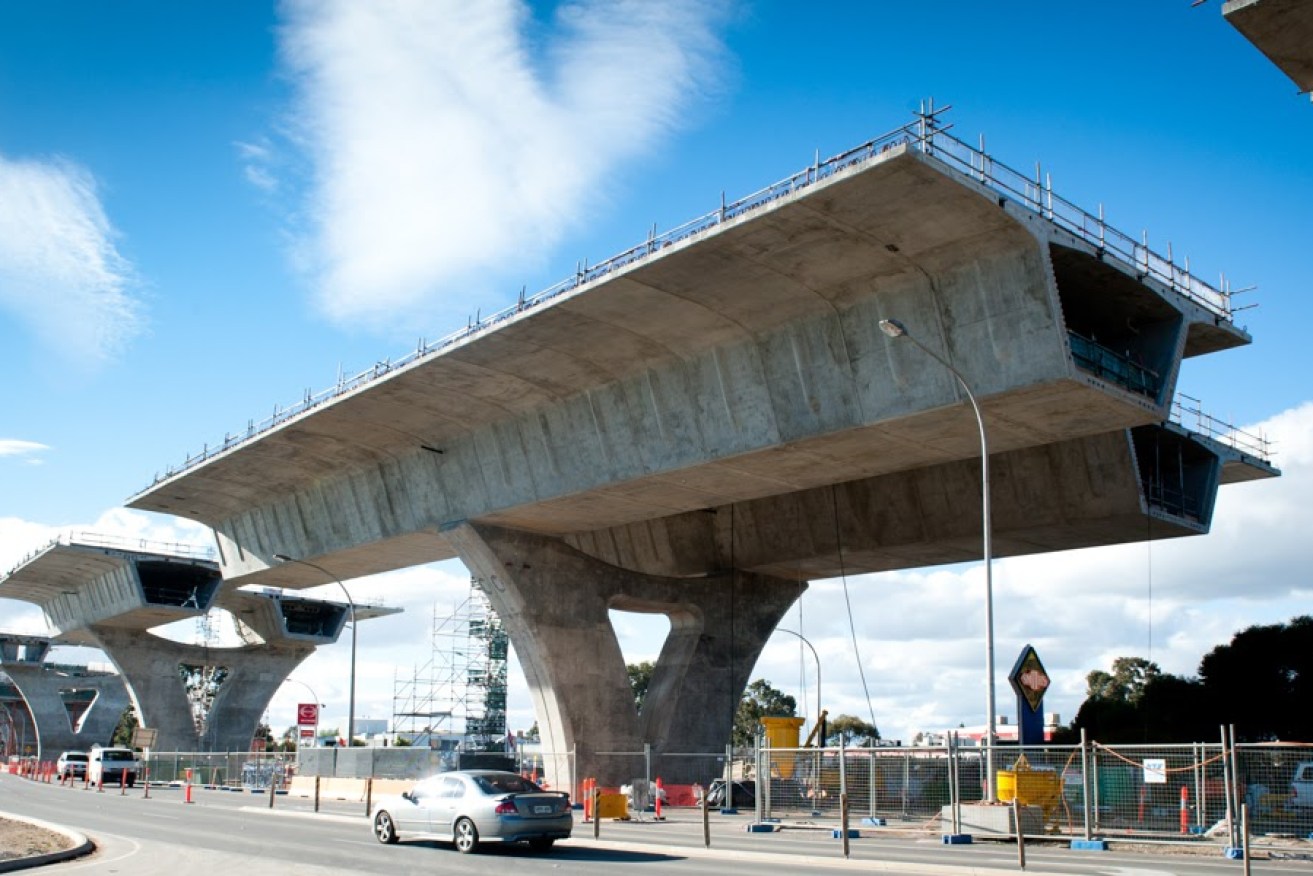Govt refuses to answer key questions on Superway steel
The State Government is refusing to answer key questions about potentially damaging steel bending practises during the construction of the South Road Superway.


The Superway under construction. Photo: Nat Rogers/InDaily.
Last year, an InDaily investigation uncovered workers’ claims that tonnes of steel reinforcement installed during $842 million build had been heated and bent at temperatures that could render the steel structurally compromised.
Now, the Department of Planning, Transport and Infrastructure (DPTI) has refused to answer specific questions about a document that suggests it declined to inspect the process of hot steel bending on the site.
Steel reinforcement bars can lose half of their strength when heated above 450 degrees celsius.
An inspections ledger, compiled by contractor Urban Superway in 2011, lists “heating and bending of bars if required” as an “inspection activity”.
However, while other inspection activities on the Inspection and Test Plan are marked with dates and initials – presumably indicating an inspection had been signed off, or completed – “heating and bending” is marked with “NA”.
A DPTI spokesperson suggested this acronym meant “not applicable”.
There is, however a date and initial for “final inspection before concrete pour”.
The Urban Superway ledger is contained within a DPTI report, presented to parliament’s Public Works Committee after it issued a ‘please explain’ to the department following the publication of InDaily’s investigation.
But the Urban Superway inspections ledger and the DPTI report appear to contradict each other.
The text of the DPTI report says that there was “ongoing surveillance” of “critical or high risk activities” involving steel reinforcement during the build.
The report also states that “rigorous processes undertaken on the project … were in place to ensure any modifications to reinforcing were approved by the designer and major changes were also reviewed by the proof engineer”.
So, what monitoring did the heat bending practice attract?
When InDaily asked about the apparently contradictory documents, DPTI refused to comment.
A spokesperson for DPTI told InDaily, however, that a “specific procedure” was developed by Urban Superway to ensure the bars were not heated above 450 degrees centigrade.
The department would not detail the nature of this “procedure” but said its use was “rare” and that it was “witnessed by Urban Superway, the designer and the [DPTI] independent reviewer”.
“… under this procedure reinforcement was not to be heated beyond 450 degrees celcius,” the spokesperson said.
“The department is unaware of any circumstances in which bars were heated beyond [450 degrees].”
Steel fixers who worked on the Superway last year described a procedure for steel heat bending in which they were given “heat pens” with which they were instructed to mark the steel.
The markings would melt and change colour when the metal reached about 450 degrees centigrade.
However, the workers said that many bars were arranged a way that made it impossible to gain the leverage to bend them without heating them above structurally safe temperatures.
The steel fixer who risked his career in the construction industry to blow the whistle on the project, Dominick Lewis, said the bars would instead be heated until they were “cherry red” and could be pushed over “with your finger”.
Other steel fixers who had worked on the Superway build, approached by InDaily last year, endorsed Lewis’s account of the procedure, but asked not to be identified, fearing legal and professional consequences.
Lewis told InDaily this week that heat bending of steel on the site was not “rare”, but “commonplace”.
Lewis conceded that he and other steel fixers were told repeatedly during the construction not to heat the bars above 450 degrees.
However, he said, they were given no explanation as to how bars that were difficult to access, where leverage could not be applied, could conceivably be bent below that temperature.
“It won’t bend, so you heat it to a point where it will bend,” he said.
“When we started we were told … these are the [heat] pens you have to use.
“[But] that was under optimum circumstances where the bars were accessible.
“I’ll accept it implicates me, but in the end there was no other way to do it [and] if I did the wrong thing, everyone did.”
DPTI would not say how “rare” the procedure was, nor in which circumstances steel bars were allowed to be bent using heat under the “procedure”.
The spokesperson did, however, say that the photographs taken covertly by workers on the site and published by InDaily last year “show bars which were removed by hot cutting (with oxygen acetylene torches) to facilitate access”.
“… in these circumstances, the bars were replaced at a later stage prior to the placement of the concrete.”
Lewis said that some of the bars removed by hot cutting were, in fact, replaced before concrete was poured.
But he said tonnes worth of reinforcement steel cut from the structure was impossible to replace once separate sections of piers that would elevate the road were connected.
And he said he witnessed concrete being poured onto parts of the structure in which he and other steel fixers had bent steel using heat.
Asked repeatedly by InDaily for further explanation of the procedure for heat bending steel, DPTI declined to comment.
“Thanks again for the opportunity to comment further, but the Department has nothing more to add to the responses we have already provided on this issue,” the spokesperson said.




